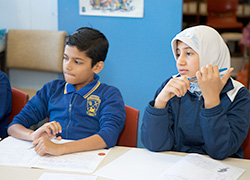English as an Additional Language or Dialect (EAL/D)
At Gosnells Primary School (GPS) we celebrate the multicultural mix of our students. We have pupils from 51 different countries, who speak over 50 different languages at home. Our school has about 420 students with approximately 245 students from culturally and linguistically diverse backgrounds, including about 40 Aboriginal students. Students’ families come from all over the world, with large groups of children from India, the Philippines, Myanmar, Pakistan, Afghanistan and New Zealand (Maori).
Teachers can access support from the EAL/D Specialist Teacher. When students arrive at GPS with gaps in their ability to communicate in English or if they have reduced Literacy skills because of EAL/D delays, the class teacher will refer them to the EAL/D Specialist Teacher for further assessment and support.
Support is carried out by assisting the class teacher in the classroom or by small group instruction focusing on particular aspects of Language and Literacy. The EAL/D teacher is also available to advise parents on how they can help their children at home. From time to time the school holds EAL/D parent sessions, with translators (if necessary) to present information to help parents understand aspects of schooling in Australia. Translators are also available for meetings between parents and teachers.
Newly arrived students (to Australia) who have limited English are referred to our local Intensive English Centre (IEC) at Thornlie Primary School, where they will access more comprehensive support. Some students are referred to the IEC for support in Year 1, after completing Pre-Primary at Gosnells Primary School.
EAL/D students are assessed and reported on, using the Education Department Progress Maps, in conjunction with the usual letter grading. This is so that they can show progress as they acquire English language skills over a number of months or even years. When the students reach a level 4 or 5 on their Progress Maps in most of the modes (Listening, Speaking, Reading & Viewing and Writing) at the end of Year 2, they would usually be at the equivalent of a level C for English. This means their English language skills are comparable with expectations for their year group and they need less EAL/D support.
If you would like more information about our EAL/D program, or to request an interpreter, please contact Cathy McGiffin (EAL/D Specialist Teacher) through the school office.
 |
 |
| Translations for this page are below: | |
| Translation Malay | Translation Hindi |
| Translation Farsi | Translation Tagalog |







